A recent Ebay listing of a Chevy Bolt EV bedecked with solar panels piqued a lot of interest in the electric vehicle community. While that Bolt EV was just an individual project car modified by its owner, Daniel McGuire, it does raise awareness about the possibility of installing solar panels on electric vehicles.
In this article, I will explore the current trends in solar EVs and predict the benefits of installing solar panels on an electric vehicle like the Chevy Bolt EV. While these systems can be used on any vehicle (even internal combustion cars with removed alternators), they make the most sense on plug-in hybrid and pure-battery electric vehicles (essentially, the cars that can use only battery energy to drive the vehicle).
Solar Basics
First, let’s talk about solar energy because the Earth is bombarded by a lot of it. On the surface, the Earth is struck by about 1,000 watts (or 1 kW) of solar energy per square meter (about 11 sq/ft). What happens to that energy from there is too complicated to cover in this article, but it ranges from being absorbed into the materials it hits, reflected back into the atmosphere, or even reflected back into space.
Photovoltaic (PV) solar panels are designed to absorb some of that energy and convert it into direct-current electricity, and they can come in a variety of shapes, sizes, compositions, chemistries, and (most importantly) efficiencies. Even our best PV solar panels at this point struggle to capture close to half of the solar energy that strikes them, which is why you see fairly large panels (more than 1 square meter) only rated for maybe 250 to 350 watts.
To make matters worse, the panel’s angle, direction, geographical location, and sun exposure also affect how much energy is available to absorb. Also, PV solar can only generate electricity when the sun is out, and in the United States, we only average about four to six hours of peak sunlight per day (though some energy is still available outside of peak sunlight hours).
However, despite all those hurdles, PV solar is still highly effective. Why? It’s a slow burn. Day after day, week after week, month after month, PV solar panels are absorbing energy from the sun and converting it into electricity. It’s not a lot, but over time, it really adds up.
A general rule of thumb is that 1 kW of installed PV solar panels will produce about 200 kWh per month. To put that into perspective, that’s enough to completely fill a Chevy Bolt EV’s battery pack three to four times per month (adding about 800 miles of driving per month). Of course, that is for a mounted solar panel system with consistent, regular sun exposure. For a far more accurate estimate based on system size, installation, and location, the National Renewable Energy Laboratory provides an awesome solar calculator.
Solar Panels on an EV
Putting PV solar on a car presents a number of challenges beyond those already faced by ground or roof mounted solar panels because a car is, literally and figuratively, a moving target.

Not only is the purpose of a car to drive around to different locations, it is also shaped for that purpose. They have angles and edges that are designed for aerodynamics, aesthetics, and interior capacity. Those angles might or might not be conducive to generating solar power at a given time of day, and poorly mounting solar panels would consume more energy while driving than they provide.
Weight is also a factor. Solar panels are not light, and they are easily as heavy as the aluminum or even steel body panels they might replace. Regardless, solar panels would be mounted on top of the existing body panels, which mean they are simply adding that weight.
Further, these PV systems add complication. In the case of Daniel McGuire’s 2,000 watt Bolt EV solar panel system, he also had to add another battery, inverter, and EVSE (electric vehicle supply equipment) to the mix. These systems can be better integrated by automakers (feeding the DC power of the PV solar panels directly into the car’s systems), but even then, they would add additional complication and weight from wiring.
Finally, there is the cost. Daniel stated that his PV system for the Bolt EV cost nearly $20,000. That’s a hard cost to justify, and it’s certainly not worth the few hundred miles of driving an EV owner might see from it each month.
Elon Musk Is Wrong about Automotive Solar
Tesla’s Elon Musk was one of the biggest names to shoot down this idea of solar on cars, stating that it was one of the worst places to install solar. While it is true that some people have access to better, more effective places to mount solar panels, few of those places provide as direct a benefit as an electric car.
Diving into Elon’s argument, it seems that he is most concerned about the cars being parked in covered garages for long periods of time. I acknowledge that, if that is someone’s specific situation, they wouldn’t see much (if any) benefit from solar panels on their car. However, many people don’t have garages, and if they do, they primarily park in them at night. For many people who have off-street parking, they still park their cars in uncovered driveways. Most people also have day jobs, and in my experience, most office parking lots are still fully exposed to the sun.
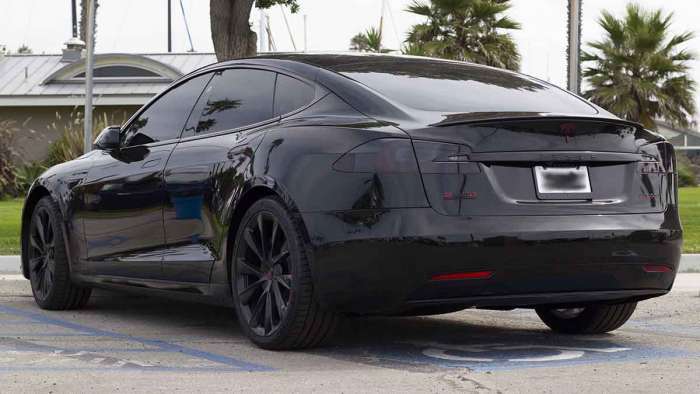
In the end, I feel that Elon’s argument is primarily borne from a disconnect with how the average American goes about their daily life; however, it could also be due to Tesla’s corporate strategies and tactics. They have a home solar panel business, so car-based solar panel systems could interfere with that. They’ve also created a value innovation with their private Supercharger Network, which is one of the most powerful marketing tools in the EV industry at this point. Cars that rarely (if ever) need to rely on the public charging infrastructure undermine that investment.
Either way, let’s take a look at some of the automakers who feel that pursuing automotive solar panels is worth their time.
Hyundai Sonata HEV
Hyundai is offering a solar option for their upcoming Sonata HEV with a solar roof that they anticipate will charge 30% to 60% of the battery per day and over 800 miles of driving per year. This solar option will add about $1,000 to the price of the car, so in a strictly dollars and cents measurement, the return on investment needs to improve.
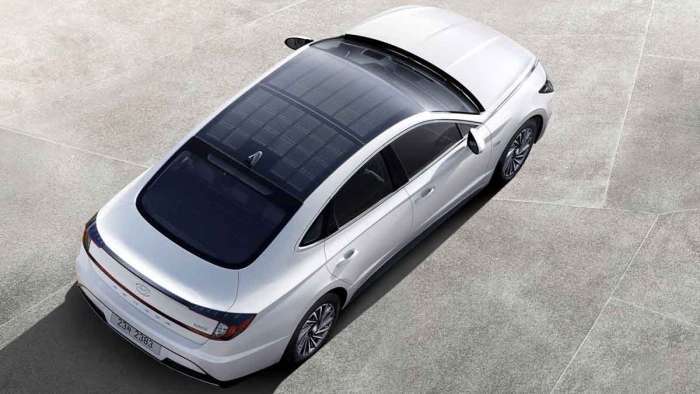
However, for vehicles that can drive strictly on electricity, this would be a valuable option that assures that the car always has a fuel source, though only adding about 2 miles of range per day means it’s really only effective for low mileage drivers. Still, I’m hoping to see Hyundai add this option to their all-electric Ioniq and Kona in the future. Hyundai just needs to reduce the price and improve the efficiency of the solar panels.
Toyota and NEDO
Speaking of efficiency, Toyota is testing far more efficient solar panels on their Prius. Not only are their solar panels 34% efficient (nearly double the efficiency of typical panels), Toyota was also able to apply 9 square feet of them.

Based on Toyota’s testing with New Energy and Industrial Technology Development Organization (NEDO) and Sharp Corporation, they were able to generate nearly 30 miles of battery electric driving range per day using these new, more efficient PV solar panels. Generating 30 miles of driving range is an important milestone, too, because it is not far off what the average American drives in a day. This system Toyota is developing, when paired with a pure battery electric vehicle, could result in an EV that the average person never needs to plug in. Toyota could be well on their way to an actual, self-charging car.
Sono Motors Sion
Sono Motors, a startup company based in Munich, Germany is already accepting preorders on their Sion, an all-electric car with built-in solar panels.
According to Sono, these solar panels will generate up to 20 miles of driving range per day, which is short of what an average American would need to cover their daily driving. However, the fact that these solar panels are paired with a 35 kWh battery pack (over 150 miles of rated range) means that most drivers could go a week or more without ever plugging in the car.
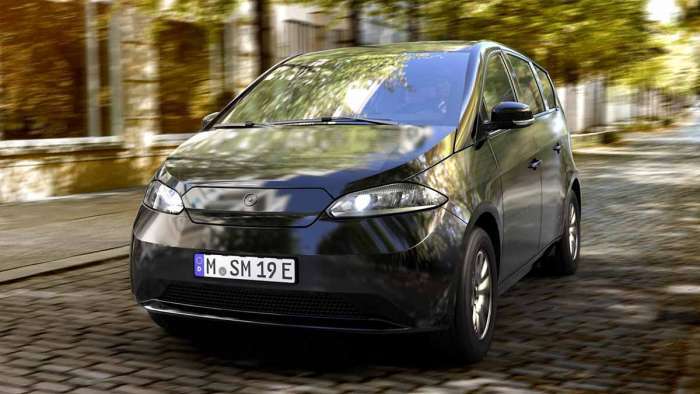
Sono already has over 10,000 preorders for the Sion, and while the numbers and specs for the Sion are only for Europe right now, the 25,500 € (just under $30,000) price tag demonstrates that an effective automotive solar panel system can be integrated in a cost-effective way.
Lightyear One
The Lightyear One is an even more compelling solar EV than the Sono Sion; however, at this time, it is far less affordable. Currently, they are only accepting deposits and orders from Europe, but the price is 149,000 € (or well over $160,000).
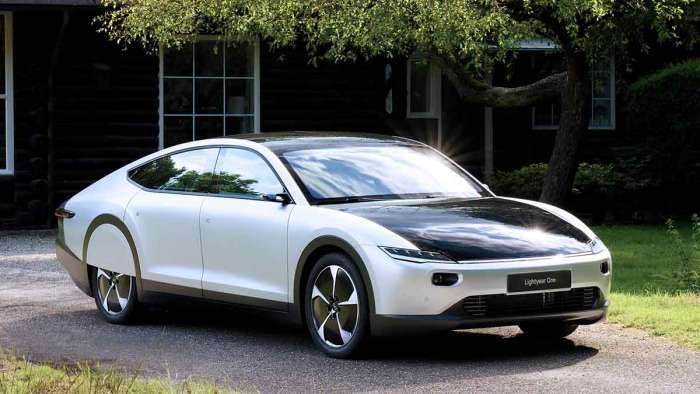
Still, despite the price, the specifications are amazing. The Lightyear One boasts nearly 500 miles of range per charge, but in full sun, the 5 square meter solar array will add over 7 miles of driving range per hour. Lightyear One even provides a cool calculator on their website that will display how many miles of driving the Lightyear One will generate from solar power alone at your location. Even as much as I drive, I would only need to plug in a few times a year.
What I find interesting about Lightyear One’s strategy is that they are taking a slightly different path in order to achieve the same goal as Toyota. While Toyota has nearly doubled the efficiency of the solar panels they are using, Lightyear One has nearly doubled the efficiency of a typical electric vehicle. A blending of the two approaches would almost certainly result in an EV that never needs to be plugged in, other than to feed excess power back into the grid.
Solar Panels on the Chevy Bolt EV
So could solar panels on the Bolt EV work? Absolutely. Given the number of companies pursuing PV solar on EVs or even plug-in hybrids, I definitely think that this is an area where GM should consider focusing. Obviously, the system would need to be integrated cleanly and allow for power generation while driving, but that is well within GM’s capability.
From my perspective, the only things holding back automotive solar panel systems right now are efficiency and cost. The efficiency can be addressed either by doing what Toyota did (improve the efficiency of the PV panels) or by doing what Lightyear One did (improve the efficiency of the EV).
As for cost, even a modest solar panel system adding only 20 miles of range per day would provide a significant value that goes far beyond simple return on investment calculations based on cost per mile. For apartment dwellers who don’t have access to charging at home, these built-in solar panels could eliminate the need to go out of the way to plug in at a public charger. For owners who are facing costly EV charger installations, this would make 120 V charging far more effective. For people who like to go off-grid or camping in the wilderness, this type of system could enable that.

As of the time I am writing this article, California is facing widespread power outages due to wildfires and wildfire prevention. These panels would give owners piece of mind that they could continue to commute to and from work, even if their home power was shut off for days at a time. Additionally, with a car-based inverter, people could power appliances and lights from their EV’s battery knowing that the energy would be replenished the next day. For those reasons alone, I would push back against anyone who suggests that these systems are simply a novelty.
See you next time when I provide an explanation of the Chevy Bolt EV’s battery charge limit systems and how and why you should use them!
About The Author
Eric Way focuses on reporting expert opinion on GM brand electric vehicles at Torque News. Eric is also an instructional designer and technical writer with more than 15 years of writing experience. He also hosts the News Coulomb video blog, which focuses on electric vehicles, charging infrastructure, and renewable energy. Eric is an active member of the EV Advocates of Ventura County, a volunteer organization focused on increasing the widespread adoption of electric vehicles. You can follow Eric on News Coulomb Youtube, on Facebook at @NewsCoulomb as well as on Twitter at @eway1978.


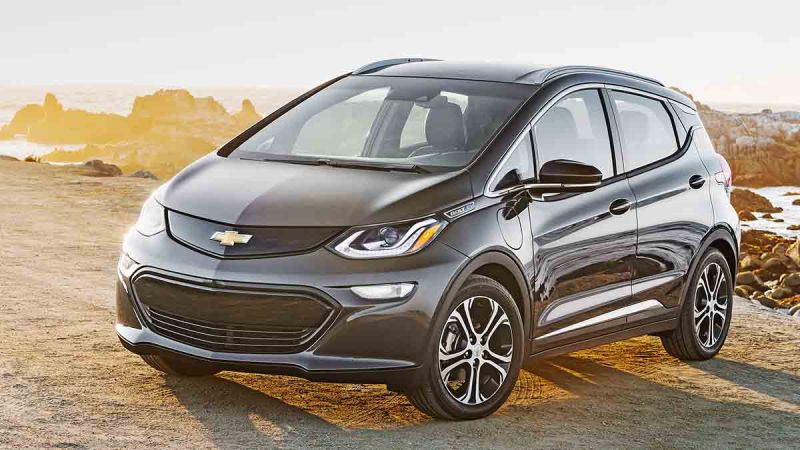










Comments
To me it comes down to the
Permalink
To me it comes down to the practicality and cost of car-solar panels.
There is only a certain amount of space on a car where you can mount solar panels, and the cost and efficiency are two other limiting factors. On the good side, an EV has batteries to store electricity and an inverter, so with much of the necessary equipment to make it work, it doesn't seem like a bad idea. But if you are looking adding say 400kW per hour in direct sunlight, and the addition of the on-board system may add as much as $2000 to the cost of the car, it's a harder decision to justify. If you have a home where you can install fixed solar panels Tesla is offering a 3.8kWh solar installation for $45 a month ($65 in CA) that produces 13-16kWh per day. My PHEV uses 12.5kW for 45 EV miles of driving, or about 3.3 cents a mile, which is a far better solar value. Now back to the Bolt. GM could certainly build in a solar panel to the roof and hood of the car, especially the larger upcoming EUV. But would the package be worth it for the price? Both Toyota and Hyundai offered models with built in solar panels, but the power yield and cost didn't provide sizable power gains or a good value. The prototype Prius shows a real gain in usable range with new high yield panels, but it does appear to have panels covering the back window. Like many innovative ideas, it is interesting. But the real world value of built-in automotive solar panels doesn't appear to be great just yet. Especially compared to home solar (where possible). So this is still a wait and see technology for me until a breakthrough in price/value happens.